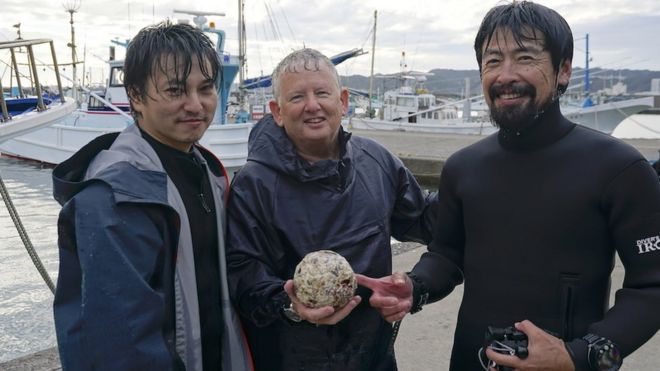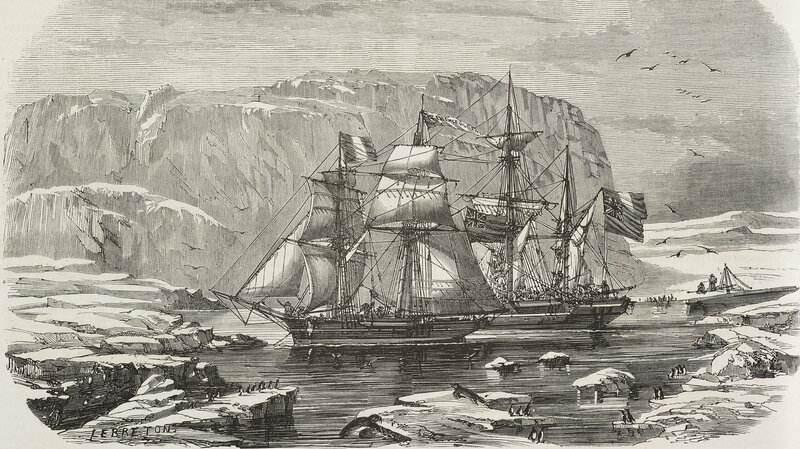HOT NEWS !
Stay informed on the old and most recent significant or spectacular
nautical news and shipwreck discoveries

-
San Francisco shipwreck: Divers find 'cannonball clue'
- On 14/11/2017
- In Underwater Archeology
- 0 comments

From BBC
The San Francisco was travelling from the Philippines to Mexico when it sank.The galleon was believed to be carrying valuable trade goods which could be worth millions today, researchers say.
Its location has been a mystery - but the suspected cannonball, thought to be the first artefact ever found from the ship, offers clues about where it sank. Dr Jun Kimura from Tokai University has been leading a team of maritime archaeologists, who have been searching for the San Francisco in waters off Iwawada in Chiba prefecture.
The cannonball was discovered by Ian McCann, an Australian researcher at the University of New England, during a deep dive nearly 40m (131 ft) below the surface.
"We were in dark, murky waters," Dr Kimura told the BBC. "Ian just saw an unusual shape on the sandy bed - he recovered it but then we had to go back to the surface as our air had nearly run out."
He said the team, and archaeological experts they had consulted, were "almost certain" it was a cannonball from the San Francisco, as it was similar to cannonballs found in other Spanish trading ships in the Philippines.
However, they will be carrying out a chemical analysis to confirm this.
-
Le naufrage du premier sous-marin militaire de l'histoire élucidé
- On 11/11/2017
- In Conservation / Preservation
- 0 comments

De Francois Savatier - Pour La Science
Un blast pulmonaire, c’est-à-dire la destruction des poumons par une onde de choc, a-t-il tué les huit premiers sous-mariniers de l’histoire ?C’est en tout cas ce que suggère l’essai qu’a mené l’équipe d’ingénieurs de Rachel Lance, du Centre pour la recherche militaire navale de Panama City, en Floride.
Bien qu'Horace Lawson Hunley (1823-1863), son inventeur, soit mort noyé au cours d’essais de routine, le sous-marin confédéré CSS HL. Hunley, un bâtiment d’une douzaine de mètres de long pour 1,2 mètre de large, fut remis à flot et remis en service.
Construit à partir de la chaudière d’un navire à vapeur, le petit sous-matin était dirigé depuis une tourelle de commande par un membre de l’équipage, pendant que sept autres le propulsaient en actionnant à la main un vilebrequin faisant tourner l’hélice.
Des lests de quille pouvaient être libérés manuellement tandis que, comme dans les sous-marins modernes, des ballasts se remplissaient d’eau afin d'avancer à demi immergé vers la cible.
Le haut de l’étrave était prolongé par un système de poutres de sept mètres de long au bout duquel était suspendu un baril de poudre à canon.
-
Parks Canada releases new images of 2017 Franklin dives
- On 10/11/2017
- In Famous Wrecks
- 0 comments

From steve Ducharme - Nunatsiaq Online
New details about Sir John Franklin’s doomed Arctic expedition continue to be discovered as archeologists examine two sunken wrecks in Nunavut’s waters.Following the announcement that the United Kingdom would transfer the shipwrecks to the country that offered them a final Arctic resting place, Parks Canada has released a new trove of underwater images of HMS Terror and HMS Erebus taken this past summer.
New images confirm that the Terror’s anchor remains on board, disproving earlier speculation from 2016 that the ship was “at anchor” when it sank—another important detail as researchers determine the timeline of events in this historic tragedy.
As well, Parks Canada says it has catalogued 64 artifacts from the Erebus, but added that no artifacts were removed from either the Erebus or Terror during the 2017 expedition.
“Through dives, Parks Canada’s Underwater Archaeology team was able to locate previously unseen artifacts, including wine bottles, on the wreck [of the Erebus],” said Parks Canada communications officer Meaghan Bradley.
The British government’s proposed transfer of the wrecks to Canada would be in exchange for “a small sample of artifacts,” the United Kingdom said in a statement.
What will be contained in that sample of artifacts has yet to be specified but Parks Canada said it “looks forward to working with the United Kingdom in the very near future to finalize the details of the artifact transfer.”
-
Odyssey Marine Exploration reports nearly nothing in revenue
- On 09/11/2017
- In People or Company of Interest
- 0 comments

From Malena Carollo - Tampa Bay Times
Tampa-based Odyssey Marine Exploration Inc.’s revenue shrunk to nearly nothing in the year’s third quarter.
The deep-sea exploration company reported just $11,854 in revenue, down from $2.9 million the same quarter last year. The company’s previous multi-million-dollar revenue came from a contract with Magellan Offshore Services, for which Odyssey conducted shipwreck expedition services.
The company recorded a net loss of $2.3 million for the third quarter, amounting to 27 cents per share. In the same quarter last year, the company reported a loss of $2.1 million, or 28 cents per share.
Just last quarter, Odyssey brought in $587,000 in revenue from marine surveys and recovery services for Magellan.
The services stem from a 2015 agreement Odyssey entered with Magellan when it sold $21 million in assets from its shipwreck business. That sale was used to wipe out Odyssey’s $11.7 million in debt.
"I’ve stated for the past nine months that although we intended to focus corporate capital on the mineral exploration side of the business, we do not intend to abandon our shipwreck roots," Odyssey CEO Mark Gordon said in a release at the time.
Per the deal, Magellan owns Odyssey’s proprietary shipwreck database and rights to shipwreck projects. Odyssey was the sole provider of shipwreck search and recovery expeditions for Magellan. It also gets just over 21 percent of proceeds from any shipwreck projects.
-
Bringing a shipwreck back to life with photogrammetry
- On 24/10/2017
- In Famous Wrecks
- 0 comments
By Steve Dent - Engadget
A little over 76 years ago, the British merchant steam ship SS Thistlegorm was sunk by a WW II German bomber off the coast of Egypt, taking nine souls down with it.It has only been seen in detail by divers, but a new website from the University of Nottingham and Egypt's Alexandria Universities lets you experience the shipwreck via immersive 3D models and 360-degree VR videos.
The underwater photogrammetry study is one of the first to use 360-degree, 3D video. Divers carried 360-degree Kolor GoPro Abyss rigs, each with six individual cameras shooting 4K Ultra HD footage.
To create a 360-degree virtual "guided tour" of the ship (below), the team mounted the Abyss system on the front of an underwater scooter. Each dive captured 50GB of data, for a total of 1.5TB of footage.
"For me, 360 video is a big step forward as it recreates the diving experience," said University of Nottingham project director Dr. Jon Henderson.
"You can get the impression of swimming over it and through the internal parts of the wreck."
To build the 3D model shown at top, the team took over 15,668 images to capture the external model of the ship and seabed, along with 11,164 interior images for the deck, holds, captain's cabin and other areas.
It took 65 days of continuous computer processing to build the five survey models.
-
U.K. offers famed Arctic shipwrecks
- On 24/10/2017
- In Famous Wrecks
- 0 comments

By Colin Dwyer - NPR.org
In an act befitting "our long shared history and the closeness of our current bilateral relationship," the U.K. has announced it will give Canada the recovered shipwrecks of John Franklin, a British explorer who sought to chart an unnavigated section of the Northwest Passage in the Arctic in the 1840s — and died in the attempt, along with all of his crew."This exceptional arrangement will recognise the historical significance of the Franklin expedition to the people of Canada, and will ensure that these wrecks and artefacts are conserved for future generations," British Defense Minister Michael Fallon said in a statement published Tuesday.
For more than a century and a half, the resting place of the two vessels remained a mystery — until a team of archaeologists finally found and identified the HMS Erebus in 2014.
Just two years later, researchers acted on a tip from an Inuit man to find the HMS Terror, the flagship of Franklin's 1845 expedition, sitting "perfectly preserved" nearby in the waters near King William Island.
Reporting at the time the HMS Erebus was found, the Toronto Star explained the enduring riddle Franklin's doomed expedition has represented:
"Sir John Franklin and 128 crewmen were lost in the original expedition. Skulls believed to be of the members of the expedition were found and buried on King William Island in 1945. "But for 167 years it has remained a mystery as to why Franklin and his men were never heard from soon after the Royal Navy had mounted one of the best equipped Arctic explorations in its history to find a possible trade route between the Atlantic and Pacific oceans."
-
Lettre d’un naufragé du Titanic
- On 24/10/2017
- In Auction News
- 0 comments

Une lettre d’un naufragé du Titanic, l’Américain Oscar Holverson, adressée à sa mère, a été vendue aux enchères, samedi en Angleterre, pour la somme de 126 000 livres sterling, soit 141 000 euros. L'hôtel des ventes Henry Aldridg Andson a publié un extrait de la lettre sur son compte Instagram.La missive datée du 13 avril 1912, soit la veille du naufrage, est composée de trois pages avec l’en-tête du Titanic, rapporte la BBC.
L’homme détaille la splendeur du paquebot. « Le bateau est d’une taille gigantesque, il est aménagé comme un palace », écrit-il avant de préciser : « Si tout va bien, nous arriverons à New York, mercredi » L’homme d’affaires américain périra le lendemain dans le naufrage.
En revanche sa femme Mary réussit à survivre.
La lettre a été retrouvée sur l’épave du Titanic, à l’intérieur d’un carnet de notes retrouvé sur le corps du défunt. Le courrier a été acheté par un collectionneur britannique.
-
New Antikythera shipwreck finds
- On 17/10/2017
- In Underwater Archeology
- 0 comments

By Peter B. Campbell - The Guardian
The shipwreck at Antikythera, Greece, continues to reveal its secrets and surprise archaeologists. As reported last week, recent excavations on the 1st century BC shipwreck have revealed statue fragments, bronze ornamentation, and wooden remains from the ship’s hull.The finds are sensational, but the artifacts and the project have broader importance. Among the finds was the bronze arm of a statue, which may be the most significant find.
When the shipwreck was first found and excavated in 1900-1901, a number of bronze and marble statues were recovered. However, the arm is the first piece that has been found recently and it might point to more intact statuary in the area.
The arm is one of several limb fragments that do not have corresponding bodies. The Antikythera team hypotheses those statues could be in the vicinity of the undisturbed deposit that they excavated this year.
New bronze statues would be a sensational discovery. Bronze statues are among the rarest artifacts to survive from antiquity; however, ancient authors tell us that they were quite common.
Pausanias wrote a Roman travel guide of Greece and he describes the many bronzes statues filling cities like Athens. In Greek Bronze Statuary Professor Carol Mattusch writes, “all ancient literary accounts indicate that freestanding bronze statuary was the primary mode of artistic expression in Classical Greece.”
Ancient cities like Athens and Rome were filled with bronze sculptures, with bronze being preferred over marble.
